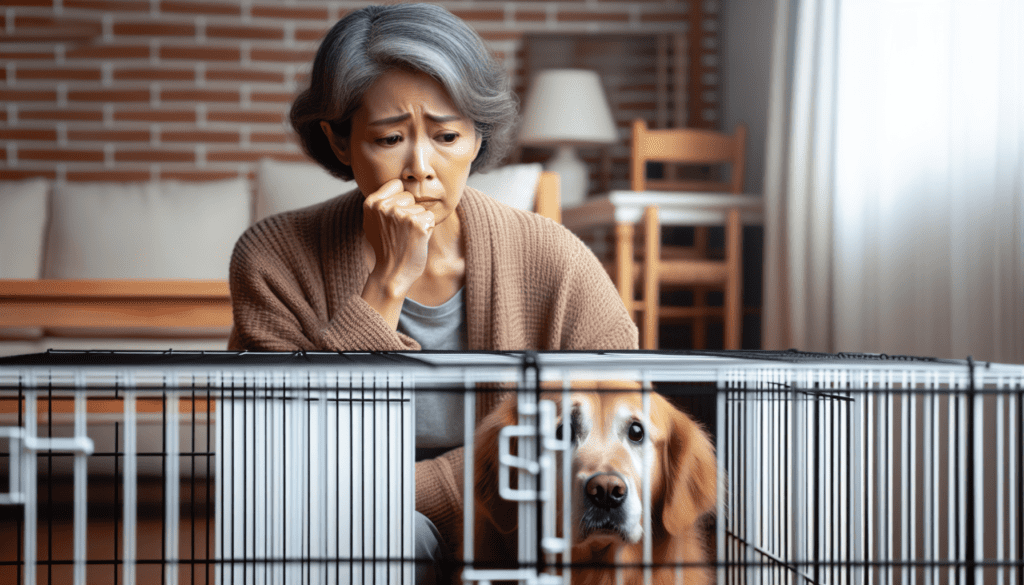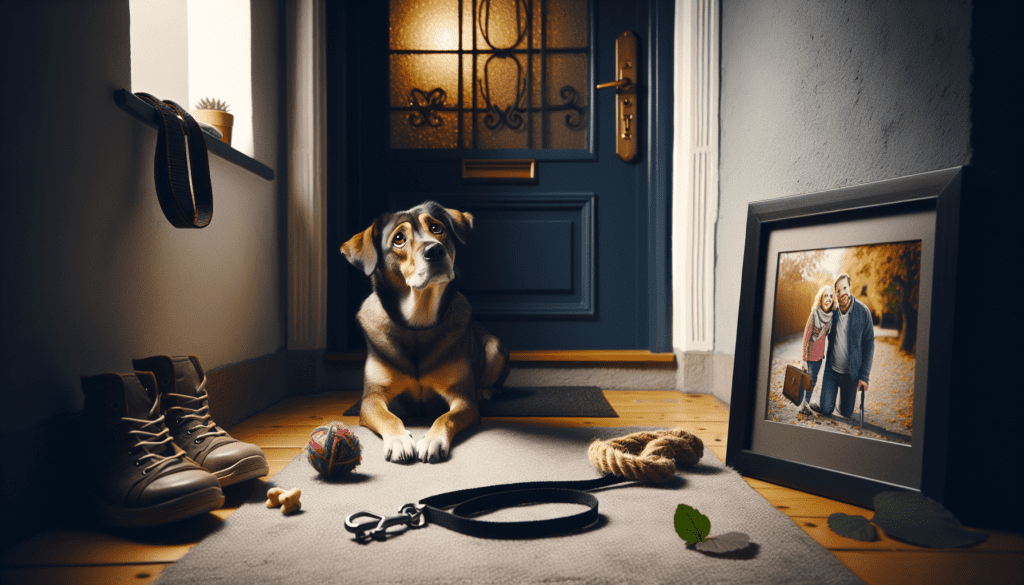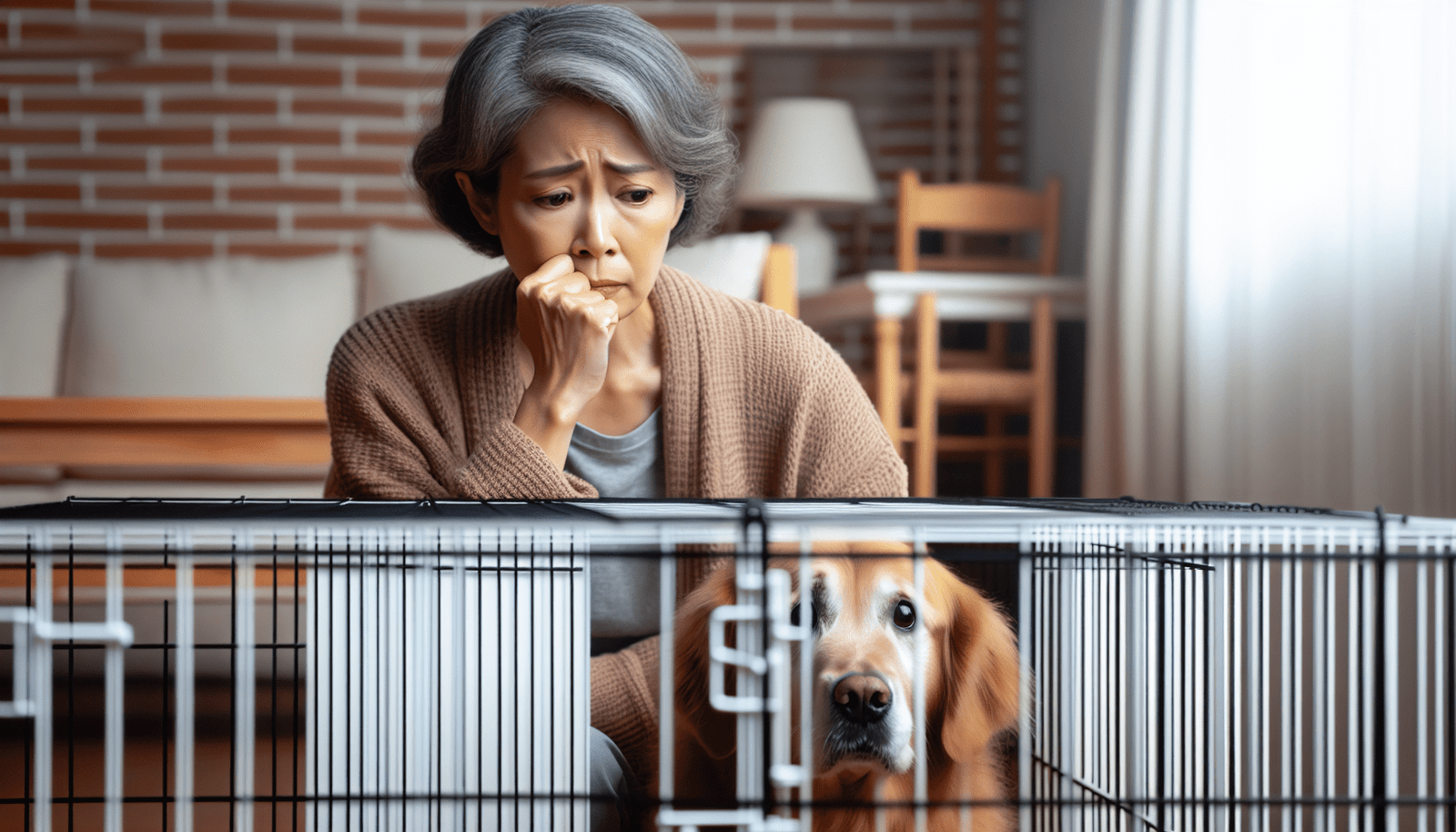Are you a dog owner struggling with your furry friend’s separation anxiety? If so, you’re not alone. Many dog owners face the challenge of leaving their pets alone without them becoming anxious or exhibiting destructive behavior. Fortunately, there are specific training methods available that can help alleviate separation anxiety in dogs. By understanding the unique needs of your canine companion and implementing effective techniques, you can help your dog feel more comfortable and secure when left alone. In this article, we will explore some of the most effective training methods for dogs with separation anxiety, providing you with practical tips and strategies to help your four-legged friend overcome their anxiety and thrive in your absence. So, let’s get started and make those tail-wagging goodbyes a little easier for both of you!
The Importance of Training for Dogs with Separation Anxiety
Separation anxiety is a common problem that many dogs experience when their owners leave them alone. It can lead to destructive behavior, excessive barking, and even self-harm. While it can be a challenging issue to address, training is a crucial tool in helping dogs cope with and overcome separation anxiety. By understanding the causes and effects of separation anxiety, utilizing behavioral modification techniques, implementing positive reinforcement training, providing environmental enrichment, considering medications, seeking professional help, creating a safe and comfortable environment, managing departure cues, and practicing consistency and patience, you can help your dog live a happier and more peaceful life.
Understanding Separation Anxiety in Dogs
Separation anxiety in dogs is a condition marked by extreme distress and anxiety when left alone. It can be triggered by various factors, including previous traumatic experiences, lack of socialization, or a sudden change in routine or environment. Dogs with separation anxiety may exhibit behaviors such as excessive drooling, pacing, scratching at doors, destructive chewing, and even attempts to escape. Understanding the underlying causes of separation anxiety is crucial in addressing this issue effectively.
The Effects of Separation Anxiety on Dogs
The effects of separation anxiety on dogs can be overwhelming. Not only does it impact their emotional well-being, but it can also lead to physical and behavioral problems. Dogs with separation anxiety often suffer from stress-related symptoms, such as a decreased appetite, weight loss, and gastrointestinal issues. Additionally, the constant fear and distress can cause them to engage in destructive behaviors, which can result in harm to themselves or damage to your home. It is essential to address separation anxiety promptly to prevent further negative effects on your furry friend.
The Benefits of Training for Dogs with Separation Anxiety
Training is a vital aspect of managing separation anxiety in dogs. It provides them with the skills and tools necessary to cope with their anxiety and maintain emotional stability when left alone. The benefits of training for dogs with separation anxiety include:
- Reduced Anxiety: Through training, dogs can learn to associate being alone with positive experiences, reducing their anxiety level over time.
- Improved Behavior: Training can teach dogs alternative behaviors to replace destructive habits, such as chewing or excessive barking, helping them channel their energy in a more constructive way.
- Enhanced Independence: By gradually increasing separation periods during training, dogs can develop a sense of independence and confidence, which leads to improved overall well-being.
- Strengthened Bond: Training sessions provide an opportunity for you and your dog to bond and build trust, promoting a deeper and more secure relationship.
Now that we understand the importance of training for dogs with separation anxiety, let’s explore some effective behavioral modification techniques.
Behavioral Modification Techniques
Behavioral modification techniques are an integral part of training dogs with separation anxiety. Here are some techniques that can help your furry companion overcome their anxiety and develop healthier coping mechanisms.
Counterconditioning
Counterconditioning involves changing your dog’s emotional response to being alone by associating it with positive experiences. Start by engaging in activities that your dog enjoys, such as playing with their favorite toy or giving them treats, while gradually increasing the time you spend apart. By pairing their alone time with enjoyable experiences, you can change their perception and help them associate being alone with something positive.
Desensitization
Desensitization involves gradually exposing your dog to situations that trigger their anxiety in a controlled and non-threatening environment. Start by leaving your dog alone for short periods of time and gradually increase the duration as they become more comfortable. It is important to ensure that your dog remains relaxed throughout the process and not to rush their progress. Patience and consistency are key when implementing desensitization techniques.
Crate Training
Crate training can be an effective method for dogs with separation anxiety, as it provides them with a safe and secure space. Start by gradually introducing your dog to the crate and associating it with positive experiences, such as treats or comfortable bedding. Allow your dog to enter and exit the crate freely, and gradually increase the time they spend inside. Crate training helps establish a routine and gives your dog a sense of security when you are not around.
Establishing a Routine
Dogs thrive on routine, and establishing a consistent daily schedule can greatly reduce their anxiety. Set specific times for feeding, exercise, playtime, and alone time. By providing a predictable routine, you can give your dog a sense of comfort and security, minimizing their anxiety when you are away. Stick to the schedule as closely as possible and avoid sudden changes, as they can trigger anxiety in dogs with separation anxiety.
By implementing these behavioral modification techniques, you can help your dog develop healthier coping mechanisms and reduce their separation anxiety. However, positive reinforcement training plays a crucial role in the overall effectiveness of training.
Positive Reinforcement Training
Positive reinforcement training is a highly effective and humane approach to training dogs with separation anxiety. This method involves rewarding desired behaviors to encourage their repetition. By focusing on positive behaviors rather than punishing undesirable ones, you create a positive learning environment for your dog. Here are some key techniques used in positive reinforcement training:
Rewards and Treats
Using rewards and treats is a powerful tool in positive reinforcement training. Whenever your dog displays a desired behavior, such as remaining calm when left alone, reward them with praise, treats, or their favorite toy. This positive association reinforces the desired behavior and encourages its repetition. Ensure that rewards are given immediately after the behavior to strengthen the connection between the behavior and the reward.
Clicker Training
Clicker training is a method that uses a small handheld device called a clicker to mark desired behaviors. The clicker produces a distinct sound that signals to the dog that they have performed the correct behavior and will be rewarded. By pairing the sound of the clicker with treats or praise, you can effectively communicate with your dog and reinforce positive behaviors. Clicker training is particularly useful in shaping new behaviors or capturing specific actions.
Marker Training
Marker training is similar to clicker training but uses a verbal cue, such as the word “yes” or “good,” to mark desired behaviors. The marker, much like the clicker, serves as an immediate signal that the dog has performed the correct behavior and a reward is on its way. By consistently using the marker followed by rewards, your dog will learn to associate the verbal cue with positive outcomes. Marker training can be highly effective in teaching complex behaviors or shaping subtle actions.
Positive reinforcement training is a gentle and effective approach to training dogs with separation anxiety. It promotes a positive learning experience and strengthens the bond between you and your pet. However, creating an enriched environment can further enhance the training process.
Environmental Enrichment
Environmental enrichment plays a crucial role in keeping your dog mentally stimulated and engaged, which can help alleviate separation anxiety. By providing various interactive toys, puzzle toys, scented toys, and audio or visual stimulation, you can help your dog stay occupied and entertained when you are not around.
Interactive Toys
Interactive toys, such as treat-dispensing toys or toys that require problem-solving, can keep your dog engaged and mentally stimulated. These toys provide a challenge for your dog, keeping their mind occupied and redirecting their focus away from their anxiety. Fill the toys with treats or food puzzles to create an engaging and rewarding experience for your furry friend.
Puzzle Toys
Puzzle toys are a great way to keep your dog entertained and mentally stimulated. They typically require problem-solving skills and reward your dog with treats or food when they successfully complete the puzzle. By keeping their mind engaged, puzzle toys can help alleviate boredom and anxiety when left alone.
Scented Toys
Scented toys can provide comfort and a sense of familiarity to dogs with separation anxiety. Rubbing the toy with your scent or using calming scents, such as chamomile or lavender, can help soothe your dog’s anxiety. Scented toys can be particularly beneficial during the initial stages of training when your dog is still adjusting to being alone.
Audio or Visual Stimulation
Providing audio or visual stimulation can help distract your dog and create a more stimulating environment. Leaving on calming music or using a television program specifically designed for dogs can help mask outside noises and provide a soothing background for your dog. Additionally, some dogs may find comfort in watching nature or animal videos, which can provide a sense of companionship.
By incorporating environmental enrichment into your dog’s daily routine, you can help alleviate their anxiety and provide them with mental stimulation. However, in some cases, medications may be necessary to manage severe separation anxiety.
Medications for Dogs with Separation Anxiety
In cases where behavioral modification techniques and training alone may not be sufficient, medications can be considered as part of a comprehensive treatment plan for dogs with separation anxiety. However, it is crucial to consult with a veterinarian before starting any medication. They can assess your dog’s specific needs and determine which medication, if any, is appropriate. Here are some key points to consider when it comes to medications for dogs with separation anxiety.
Consulting with a Veterinarian
A veterinarian’s guidance is essential when considering medications for dogs with separation anxiety. They can evaluate your dog’s symptoms, rule out any underlying medical conditions, and recommend an appropriate treatment plan. They may also refer you to a veterinary behaviorist, who specializes in animal behavior, if necessary.
Common Medications Used
Selective serotonin reuptake inhibitors (SSRIs) and tricyclic antidepressants (TCAs) are commonly prescribed medications for dogs with separation anxiety. These medications work to regulate neurotransmitters and help reduce anxiety symptoms. Benzodiazepines may also be prescribed for short-term relief from severe anxiety episodes, but they should be used with caution due to their potential for dependence.
Effects and Side Effects
Medications for separation anxiety can have different effects and side effects depending on the individual dog. It is important to closely monitor your dog’s response to medication and report any changes or concerns to your veterinarian. Common side effects may include drowsiness, decreased appetite, gastrointestinal upset, or changes in behavior. Your veterinarian will provide guidance on proper dosage and any necessary adjustments.
Medications can be a valuable tool in managing severe separation anxiety in dogs. However, it is crucial to work closely with your veterinarian to ensure the best course of treatment for your furry friend.
Seeking Professional Help
In some cases, seeking professional help from a certified professional dog trainer or a veterinary behaviorist may be necessary. These experts have specialized knowledge and experience in dealing with separation anxiety in dogs and can provide valuable guidance and support throughout the training process.
Working with a Certified Professional Dog Trainer
A certified professional dog trainer can design a training plan tailored to your dog’s specific needs and offer personalized guidance throughout the training process. They can help you implement effective techniques, troubleshoot challenges, and provide ongoing support and encouragement. Working with a professional can enhance the effectiveness of training and ensure that you are addressing your dog’s separation anxiety in the most appropriate way.
Consulting with a Veterinary Behaviorist
A veterinary behaviorist is a veterinarian who has obtained additional training in animal behavior. They specialize in diagnosing and treating behavioral issues in animals, including separation anxiety. A veterinary behaviorist can conduct a comprehensive assessment of your dog’s behavior and provide a personalized treatment plan that may include a combination of training, environmental management, and medications, if necessary.
Seeking professional help can give you access to expert guidance and increase the likelihood of successful outcomes when dealing with separation anxiety in dogs. Remember, you are not alone in this journey, and there are professionals available to support you and your furry companion.
Creating a Safe and Comfortable Environment
Creating a safe and comfortable environment is crucial for dogs with separation anxiety. By providing them with a dog-friendly space and using calming products and scents, you can help alleviate their anxiety and create a soothing atmosphere.
Providing a Dog-friendly Space
Designating a specific area in your home as a dog-friendly space can help your furry friend feel secure and relaxed. This space should have comfortable bedding, favorite toys, and access to water. Consider placing the dog-friendly space in a quiet area away from high traffic areas or windows to minimize external stimuli that may trigger anxiety.
Calming Products
Calming products, such as pheromone diffusers or sprays, can help create a soothing environment for dogs with separation anxiety. These products mimic the natural pheromones that dogs produce when they are calm and content. By diffusing these pheromones into the air or applying them to your dog’s bedding, you can help promote a sense of relaxation and comfort.
Comforting Scents
Introducing comforting scents can help soothe dogs with separation anxiety. Consider using scented candles, room sprays, or essential oil diffusers with calming fragrances, such as lavender or chamomile. These scents can have a calming effect on dogs and create a peaceful atmosphere.
By creating a safe and comfortable environment, you can help your dog feel secure and alleviate their separation anxiety. Additionally, establishing a gradual departure and arrival routine can help your dog adjust to your absence more easily.
Establishing a Gradual Departure and Arrival Routine
A gradual departure and arrival routine can help your dog feel more secure and minimize anxiety when you leave and return home. By implementing specific preparation techniques, practicing gradual departures, and introducing gradual reintroductions, you can make the transition smoother for your furry friend.
Preparation Techniques
Before leaving, engage in activities that help your dog associate your departure with positive experiences. For example, you can provide a puzzle toy filled with treats or practice a short training session. This not only distracts your dog but also leaves them with a positive association of your departure.
Gradual Departures
Start by leaving your dog alone for short periods of time, gradually increasing the duration as they become more comfortable. During your departures, ensure that your dog has access to their favorite toys, treats, and environmental enrichment. Use calming scents or music to create a soothing atmosphere. By gradually extending the time you spend apart, you can help your dog develop confidence and realize that you will eventually return.
Gradual Reintroductions
When you return home, it’s important to practice gradual reintroductions to prevent your dog from associating your arrival with high levels of excitement. Enter the house calmly and avoid responding to any excessive greetings. Wait for your dog to settle down before giving them attention or engaging in play. By rewarding calm behavior, you can reinforce the idea that a calm response to your arrival is more desirable.
By establishing a gradual departure and arrival routine, you can help minimize the anxiety your dog experiences when you leave and return home. Now let’s explore how managing departure cues and practicing consistency and patience can further enhance the training process.

Managing Departure Cues
Dogs with separation anxiety often pick up on specific departure cues that signal your imminent departure. By changing routine patterns and altering certain cues, you can help minimize their anxiety.
Changing Routine Patterns
Dogs are highly observant and learn to associate specific patterns with your departure. By changing these patterns, you can help prevent your dog from becoming anxious. For example, if you always put on your shoes and grab your keys before leaving, try putting on your shoes at different times throughout the day without actually leaving. This can help desensitize your dog to these cues and reduce their anxiety.
Changing Clothing or Accessories
Similar to changing routine patterns, altering your clothing or accessories can help minimize departure cues. Dogs often recognize clothing or accessories that you typically wear when leaving the house. Try wearing different outfits or incorporating new accessories into your daily routine. This can help break the association between your appearance and your departure.
By managing departure cues, you can help reduce your dog’s anxiety and prevent unwanted behaviors associated with separation anxiety. Lastly, consistency and patience are vital throughout the training process.
Consistency and Patience
Consistency and patience are key when training dogs with separation anxiety. It is important to remain dedicated to their training and provide them with the time and understanding they need to overcome their anxiety.
Consistent Training Methods
Consistency is essential in reinforcing positive behaviors and breaking negative patterns. Ensure that everyone involved in the care of your dog follows the same training methods and routines. By establishing consistent expectations, your dog will learn to rely on their newly acquired skills and feel more secure in your absence.
Understanding Results Take Time
Resolving separation anxiety in dogs is a gradual process, and it’s important to have realistic expectations. While some dogs may show progress quickly, others may require more time and patience. Be prepared for setbacks and celebrate small victories along the way. Recognize that each dog is unique, and their progress will vary. With consistent training and a positive approach, you can help your dog overcome their separation anxiety.
In conclusion, training is an essential tool in helping dogs with separation anxiety lead happier and less anxious lives. By understanding separation anxiety, utilizing behavioral modification techniques, implementing positive reinforcement training, providing environmental enrichment, considering medications when necessary, seeking professional help, creating a safe and comfortable environment, managing departure cues, and practicing consistency and patience, you can effectively address separation anxiety in your beloved furry friend. Remember, with your dedication and support, your dog can overcome their anxiety and thrive.


